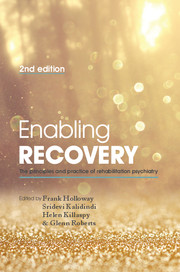Book contents
- Frontmatter
- Contents
- List of contributors
- List of figures, tables and boxes
- Preface
- Part 1 Setting the scene
- Part 2 Treatment approaches
- 7 Treatment approaches: overview
- 8 Rehabilitation at the coalface: practical approaches to helping people improve their functional skills
- 9 Cognitive approaches: cognitive–behavioural therapy and cognitive remediation therapy
- 10 Family interventions
- 11 Working with challenging behaviour
- 12 Working with coexisting substance misuse
- 13 Creative therapies and creativity
- 14 Management of medication when treatment is failing
- 15 Physical healthcare
- Part 3 Key elements of a rehabilitation service
- Part 4 Special topics in psychiatric rehabilitation
- Part 5 Future directions
- Index
12 - Working with coexisting substance misuse
from Part 2 - Treatment approaches
Published online by Cambridge University Press: 02 January 2018
- Frontmatter
- Contents
- List of contributors
- List of figures, tables and boxes
- Preface
- Part 1 Setting the scene
- Part 2 Treatment approaches
- 7 Treatment approaches: overview
- 8 Rehabilitation at the coalface: practical approaches to helping people improve their functional skills
- 9 Cognitive approaches: cognitive–behavioural therapy and cognitive remediation therapy
- 10 Family interventions
- 11 Working with challenging behaviour
- 12 Working with coexisting substance misuse
- 13 Creative therapies and creativity
- 14 Management of medication when treatment is failing
- 15 Physical healthcare
- Part 3 Key elements of a rehabilitation service
- Part 4 Special topics in psychiatric rehabilitation
- Part 5 Future directions
- Index
Summary
Workers need to recognise that people with multiple complex problems (dual diagnosis) can, and do, recover. Seeing opportunities for change and believing that these can be achieved makes a big difference. Leroy Simpson (service user) (Kipping & Simpson, 2010)
Introduction: a challenging context
Dual diagnosis, in this context the coexistence of substance misuse and severe mental illness, has been officially identified as ‘the most challenging clinical problem that we face’ (Department of Health, 2004: p. 1). Despite prevalence studies drawing on different samples, measures and time frames, a consistent finding is that at least a third of people with schizophrenia or other psychotic disorders also have problems with substances (Regier et al, 1990; Menezes et al, 1996; Weaver et al, 2002; Kavanagh et al, 2004; Carra et al, 2012). Alcohol and cannabis are the substances most frequently used and polysubstance use is common (Weaver et al, 2002; Kavanagh et al, 2004; Barrowclough et al, 2010).
The challenges of working with ‘dual diagnosis’
Service user factors
‘Dual diagnosis’ implies just two areas of need, yet people with coexisting mental health and substance misuse problems usually have multiple needs. They may have more than one mental health diagnosis (e.g. psychosis and anxiety, depression or personality disorder), be misusing more than one substance, have physical health problems (often triggered or exacerbated by substance misuse) and have a range of social difficulties.
When compared with people with mental illness alone, people with dual diagnosis have higher rates of suicidal and violent behaviour, homelessness, hepatitis and HIV infection, more contact with the criminal justice system, worse psychiatric symptoms, poorer adherence with medication, make greater use of institutional services, and have longer hospital admissions (Banerjee et al, 2002; Department of Health, 2002; NICE, 2011a). Nevertheless, people enjoy using substances. Some find them helpful in managing mental health symptoms and many are not ready to stop (Barrowclough et al, 2010). Even if people do want to modify their use, change can be difficult and relapse is common.
- Type
- Chapter
- Information
- Enabling Recovery , pp. 188 - 207Publisher: Royal College of PsychiatristsPrint publication year: 2015

